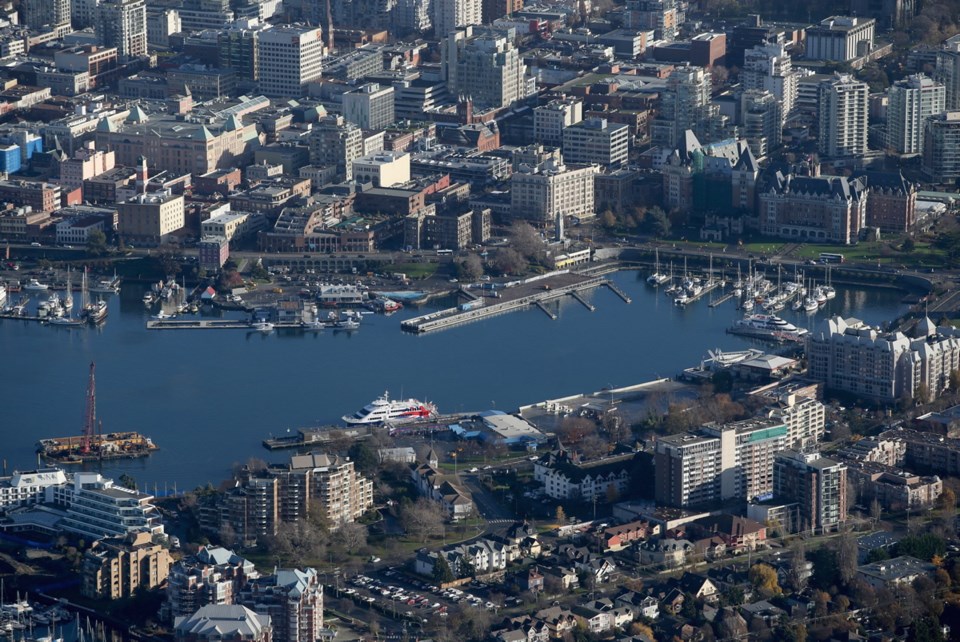Victoria faces big-city problems, and potential, as an industrial land shortage and high demand for office and retail space characterize the province’s strongest commercial real estate market outside the Lower Mainland.
Up island, Nanaimo is setting records for building permits, while giant mothballed projects from Colwood to Comox and Ucluelet are shaking off the dust and putting stakes in the ground.
It is all related to population growth in one of the fastest-growing regions in Canada, with the population of the central Island alone forecast to surpass 500,000 within the next 10 years, from 460,000 today, according to B.C. Stats.
Construction is now the Island’s second-largest employer, said Woody Hayes, former president of the Institute of Chartered Accountants of B.C., who helped compile a recent checkup on the Island’s economy.
In downtown Victoria, the office vacancy rate began the year at 6.4 per cent, down from 7.2 per cent a year earlier, according to CBRE, and it could drop to below six per cent this year, despite the addition of 280,000 square feet of new space in 2018.
“The main drivers for the office market in Greater Victoria remain the technology and government sectors,” said Elyse Norgaard Kituri, chairwoman of the Victoria chapter of the Building Owners and Managers Association of B.C. “There’s a particular demand from government for Class A office space.”
A major addition to the office scene is the Merchant House Capital makeover of the Times Colonist building on Douglas Street, which is being transformed into 120,000 square feet of office space and about 10,000 square feet of retail, including a brewpub, as the Victoria Press Building. The Times Colonist has taken space in the complex and a private college, Sprott Shaw, has also leased space, said Nathaniel Simpson, leasing agent with CBRE Victoria.
Greater Victoria’s vacancy rate for industrial properties is at a 10-year low of 1.7 per cent as the region faces a “critical undersupply” of industrial-zoned land, said a report from Colliers International.
Russ Marshall, senior vice-president with CBRE Victoria, said Greater Victoria is attracting investors and developers from the Lower Mainland searching for higher yields.
In Colwood, Vancouver-based Onni is building Colwood Corners, a mixed-use development the company rescued from default five years ago. Scheduled for completion in 2021, the development will include 152,000 square feet of commercial space and, eventually, more than 450 homes.
Onni is also behind the resurrection of a 360-acre mixed-use, residential-heavy waterfront development at Ucluelet on the Island’s West Coast, where Onni purchased the bankrupt Wyndansea project in 2015.
In the Comox Valley, the former Kensington Island Properties development, which shut down nearly a decade ago, has been revised as Union Bay Estates, which could become the largest Island real estate development north of Victoria. Plans call for more than 2,900 homes on the 349-acre site, in a number of phases.
But while land clearing is visible on the property, no infrastructure has been put in place, according to Jennifer Steel, manager of corporate communications for the Comox Valley Regional District, which provided an updated master development agreement for the project two years ago.
There is no such ambiguity in Nanaimo, where a record-setting construction pace is well underway. As of the end of June, Nanaimo’s building permit values had already hit $300 million, compared with $216 million in all of 2018, said Arit Manhas, Nanaimo’s economic development officer.
While 75 per cent of the new construction is residential, Manhas noted that three new hotels are also underway, including a $22-million, 172-room Four Points by Sheraton being built next to city’s conference centre.
Other non-residential projects include a $12-million private medical office complex and “skyrocketing” construction at Nanaimo Airport, led by a $15-million expansion project. The Port of Nanaimo is starting a $34-million upgrade that will increase marina capacity by more than 50 per cent.
Current Nanaimo housing projects total nearly 700 units. Much of the work is downtown, where the city provides a 10-year property tax exemption for eligible residential and commercial projects.
The number of permits could increase dramatically when development starts on One Terminal Avenue, a high-density, mixed-use, 7.16-acre waterfront site in downtown Nanaimo, now accepting developer bids.
“The Island economy is now based on an influx of people from across Canada, including from Metro Vancouver,” Hayes said.



